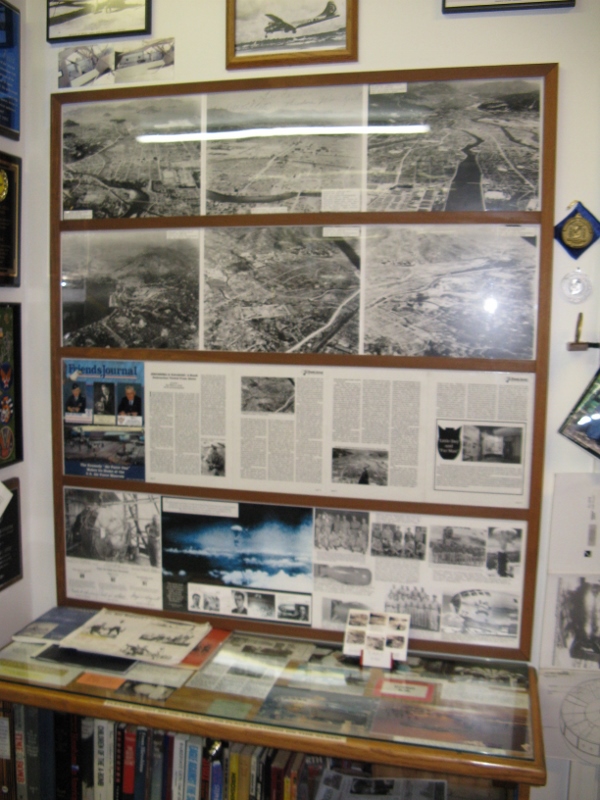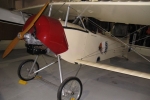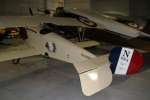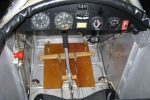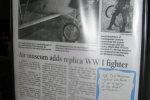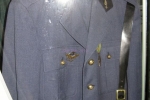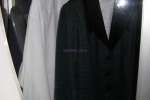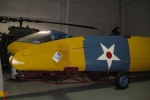1⁄1Nieuport, Glider & A-Bomb Photo
This little Nieuport is hangered at the museum.
Also on display is a 1941 Pratt-Read LNE-1 two-place, side-by-side US Navy Training Glider. "In 1952, a LNE-1 set a world altitude record for a glider of 44,255 feet."
A unique group of artifacts at the museum is a special collection of "unofficial" photos of Hiroshima and Nagasaki just after Allied troops began the occupation. The atom bomb damage was photographed by a young USAAF gunner/aerial photographer, Mr. Bill Jones. He kept extra film for himself, hidden, until the 1980s. Wondering what to do with such unique images, he contacted Gen. Paul Tibbets, who helped the film "come out of the cold". Mr. Jone's story of the revelation of the film that was not meant to be, of Governmental bureaucracy and certain laws, and the possibility of going to prison for having the film, is highly entertaining. Eventually, Gen. Tibbets' military and governmental connections prevailed and Mr. Jones presented his collection to the Smithsonian Institution in Washington, D.C.
Mr. Jones occasionally is at the museum and enjoys telling the story. His first hand account of Hiroshima and Nagasaki mere days after VJ Day - the Japanese preparations against the planned Allied invasion that were being discovered on the ground - may change opinions of people who think the atom bombings were too much.
This is a small slice of what Aeroscale features of the Hoosier Air Museum. A more in-depth feature can be found by clicking the link RELATED LINKS Feature Hoosier Air Museum, below right. It will take you to the title feature.
Also on display is a 1941 Pratt-Read LNE-1 two-place, side-by-side US Navy Training Glider. "In 1952, a LNE-1 set a world altitude record for a glider of 44,255 feet."
A unique group of artifacts at the museum is a special collection of "unofficial" photos of Hiroshima and Nagasaki just after Allied troops began the occupation. The atom bomb damage was photographed by a young USAAF gunner/aerial photographer, Mr. Bill Jones. He kept extra film for himself, hidden, until the 1980s. Wondering what to do with such unique images, he contacted Gen. Paul Tibbets, who helped the film "come out of the cold". Mr. Jone's story of the revelation of the film that was not meant to be, of Governmental bureaucracy and certain laws, and the possibility of going to prison for having the film, is highly entertaining. Eventually, Gen. Tibbets' military and governmental connections prevailed and Mr. Jones presented his collection to the Smithsonian Institution in Washington, D.C.
Mr. Jones occasionally is at the museum and enjoys telling the story. His first hand account of Hiroshima and Nagasaki mere days after VJ Day - the Japanese preparations against the planned Allied invasion that were being discovered on the ground - may change opinions of people who think the atom bombings were too much.
This is a small slice of what Aeroscale features of the Hoosier Air Museum. A more in-depth feature can be found by clicking the link RELATED LINKS Feature Hoosier Air Museum, below right. It will take you to the title feature.
Copyright ©2021 by Frederick Boucher. Images also by copyright holder unless otherwise noted. The views and opinions expressed herein are solely the views and opinions of the authors and/or contributors to this Web site and do not necessarily represent the views and/or opinions of AeroScale, KitMaker Network, or Silver Star Enterrpises. Images also by copyright holder unless otherwise noted. Opinions expressed are those of the author(s) and not necessarily those of AeroScale. All rights reserved. Originally published on: 2016-07-29 00:00:00. Unique Reads: 17661




